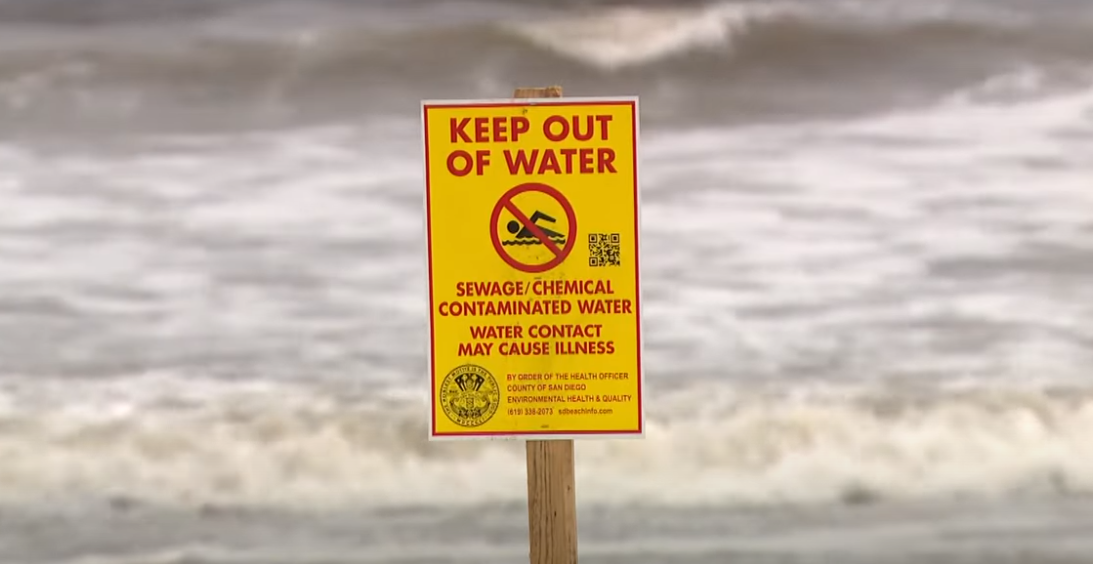- Raw sewage spills continue unabated.
- New funding aims to repair treatment plants.
- Construction delays keep beaches closed.
- Air purifiers bring short-term relief.
February 25, 2025 — Sewage flowing from rapidly growing Tijuana has plagued communities on both sides of the U.S.-Mexico border. According to Vivian Zhang, writing for San Diego 350 , “100 years, 70 billion gallons of sewage, 1,000 days of beach closures, and at least 2,000 residents affected. The Tijuana River Crisis has had far too little attention considering the size of the issue and its destructiveness to the well-being of bordering communities.” While local governments on both sides have long recognized the crisis, solutions have proven difficult, with aging infrastructure, industrial contaminants, and public health concerns all adding to the complexity.
, “100 years, 70 billion gallons of sewage, 1,000 days of beach closures, and at least 2,000 residents affected. The Tijuana River Crisis has had far too little attention considering the size of the issue and its destructiveness to the well-being of bordering communities.” While local governments on both sides have long recognized the crisis, solutions have proven difficult, with aging infrastructure, industrial contaminants, and public health concerns all adding to the complexity.
Funding and Upgrades.
In 2019, $300 million from USMCA funds was earmarked to double capacity at the South Bay International Wastewater Treatment Plant (SBIWTP). However, as reported by The Coronado Eagle & Journal  (January 2, 2025), the plant’s neglect drove the price tag to roughly $600 million, prompting fresh pleas for federal support. On December 20, President Biden signed a federal funding bill committing another $250 million toward urgently needed repairs and expansion. “We talked about funding and declaring a state of emergency, which is what needs to happen,” said Imperial Beach Mayor Paloma Aguirre. While these investments address significant infrastructure gaps, industrial waste remains largely untreated, leaving the community still vulnerable.
(January 2, 2025), the plant’s neglect drove the price tag to roughly $600 million, prompting fresh pleas for federal support. On December 20, President Biden signed a federal funding bill committing another $250 million toward urgently needed repairs and expansion. “We talked about funding and declaring a state of emergency, which is what needs to happen,” said Imperial Beach Mayor Paloma Aguirre. While these investments address significant infrastructure gaps, industrial waste remains largely untreated, leaving the community still vulnerable.
This report is just the latest proof that the sewage flowing through the Tijuana River Valley is making San Diegans sick. I’ve brought home $650 million dollars of federal funding to address the Tijuana River Valley crisis and I will keep working until we finally end this crisis. https://t.co/l3Sgn6x7y4
— Congresswoman Sara Jacobs (@RepSaraJacobs) February 21, 2025
Delayed Mexican Facility.
Farther south, the San Antonio de los Buenos wastewater treatment plant in Baja California has been dumping more than 17 million gallons of raw sewage per day into the Pacific. Officials said repairs would be finished by September 2024, but design flaws and the use of improper pumps caused setbacks. Baja California’s government indicated the plant’s repairs
Baja California’s government indicated the plant’s repairs were nearly done, with full transfer “going to be completed by March.”
were nearly done, with full transfer “going to be completed by March.”
Public Health Measures.
As the crisis lingers, air and water quality issues persist. “San Antonio de los Buenos has been finished,” stated Dr. Maria-Elena Giner of the International Boundary and Water Commission , yet industrial pollutants still pose hazards. In response, the San Diego County Air Pollution Control District has distributed 10,000 air purifiers
, yet industrial pollutants still pose hazards. In response, the San Diego County Air Pollution Control District has distributed 10,000 air purifiers to affected South Bay households. Officials emphasize that these purifiers provide only short-term relief, as deeper water treatment efforts are necessary to curb cross-border contamination.
to affected South Bay households. Officials emphasize that these purifiers provide only short-term relief, as deeper water treatment efforts are necessary to curb cross-border contamination.
Ongoing Monitoring and Spill Events.
The U.S. Section of the International Boundary and Water Commission reports frequent spills and transboundary flows. Data from the California Water Board reveals millions of gallons of sewage escaping the system through canyon collectors and pump station failures. Despite some improvements as reported by the International Boundary and Water Commission’s February 24, 2025 “news flash” showing that water quality permit compliance was achieved in November—major challenges remain.
reveals millions of gallons of sewage escaping the system through canyon collectors and pump station failures. Despite some improvements as reported by the International Boundary and Water Commission’s February 24, 2025 “news flash” showing that water quality permit compliance was achieved in November—major challenges remain.
Collaboration between Mexico and the United States continues, with each side intent on addressing the crisis. Still, residents of Tijuana, Imperial Beach, and surrounding communities wait for a permanent solution that will restore public health, preserve local ecosystems, and finally put an end to decades of beach closures and toxic exposure.
Video via NBC 7 San Diego:





Leave a Reply